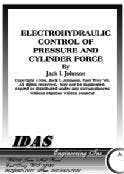Dynamic analysis is required in order to understand how compressibility affects the implementation of hydraulic pressure control. The hydraulic time constant is introduced, as is dynamic analysis by showing pressure variations in circuits that have laminar orifices and fluid compressibility.
Valve control of pressure inevitably involves the nonlinear effects of knife-edged orifices, and this is covered in considerable detail. Also covered is the manner in which control loop gain becomes non-linear, including formulas for calculating the point of maximum loop gain. The non-linearities must be understood in order to achieve good pressure control with servo and proportional valves.
The subject of integral (PID, for example) control is introduced, and both analytical and experimental results are used to show how challenging it is to achieve good control in systems that require a period of velocity or position control and then must switch to pressure control and back again. The book ends with a chapter on force control using cylinders.
The series presented here in "Motion Control," is one chapter from the book and is intended to give an overview of the many ways in which servo and proportional valves can be used to achieve effective pressure control. For more information, call IDAS Engineering tollfree at (877) 432-7364, e-mail [email protected], or visit www.idaseng.com


